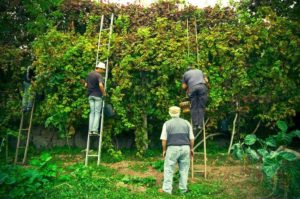Yellow with hints of green color; vivid apple, orange on the nose; lime, grapefruit, citrus, tart green apple, orange on the palate.
Slight effervescence, great acidity, off-dry with fruitiness, rich in style (especially for vinho verde), refreshing, minerality. Very tasty, fun, terrific as a summer sipper and as an aperitif.
“Green wine” is the literal translation of vinho verde, but it actually means “young wine” to the makers. Vinho verde wines are made in the historic district of Minho province in the northernmost part of Portugal. It is the largest wine area in Portugal and one of the oldest. The region is notable for its many small growers—more than 19,000 different, independent vineyards grow grapes for Vinho Verde wines.
Vinho verde is not a varietal grape, but a method of production. This bottle contains 60% arinto (bright acidity), 30% azal (freshness and citrus), and 10% loureiro (vivid aromatics). Vinho verde can be red, white, or rosé, but most production is white, especially for export market. The slight effervesce traditionally came from malolactic fermentation in the bottle, but modern makers add carbonation so there will not be sediment created by the malo method.
The young, vibrant element of vinho verde is the distinctive hallmark of the style. Grapes deliver superb acidity and fruitiness; the wines are typically made to drink very young, although some can age for up to 10 years. Most grapes for vinho verde wines are grown on high pergolas so there can be another food crop grown on the ground and to get bunches well above the ground because the Vinho Verde region has heavy rainfall. Its climate is similar to the Pacific Northwest coast; many places receive around 80 inches or rain each year. Distinctively, the pergola system requires picking grapes using ladders. The effort is worth it.
Vera Vinho Verde Bianco 2015 is superb example of the type. $10-12
Second photo: Vinho Verde harvest


